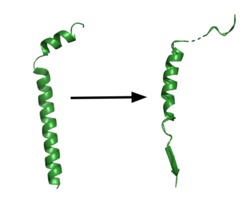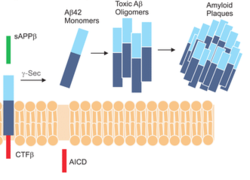Sandbox Reserved 1619
From Proteopedia
(Difference between revisions)
| Line 28: | Line 28: | ||
===Active Site=== | ===Active Site=== | ||
| - | The <scene name='83/832945/Asp_257_and_asp_385/13'>active site</scene> is located between TM6 and TM7 of the PS1 subunit, which is mainly hydrophilic and disordered. Both TM6 and TM7 contribute an aspartate residue to the active site. These two aspartates, Asp257 and Asp385 are located approximately 10.6 A˚ apart when inactive.<ref name="Bai">PMID:26280335</ref> Substrate recognition is controlled by the closely spaced PAL sequence of <scene name='83/832945/Asp_257_and_asp_385/11'>Pro433, Ala434, and Leu435</scene>. GS becomes active upon substrate binding, when TM2 and TM6 each rotate about 15 degrees to more closely associate. Two β-strands are induced in PS1, creating an <scene name='83/832945/Beta_sheet_complex/1'>antiparallel β-sheet</scene> with the β-strand of the substrate.<ref name="Zhou" /> The β-strand of the substrate interacts via main chain H-bonds with the PAL sequence, stabilizing the active site. <scene name='83/832945/Asp_257_and_asp_385/10'>Asp257 and Asp385</scene> hydrogen bond to each other and are located 6–7 Å away from the scissile peptide bond of the substrate, allowing catalysis to occur.<ref name="Yang" /> GS cleaves in 3 residue segments which is driven by the presence of three amino acid binding pockets in the active site. <ref name="Bolduc" /> | + | The <scene name='83/832945/Asp_257_and_asp_385/13'>active site</scene> is located between TM6 and TM7 of the PS1 subunit, which is mainly hydrophilic and disordered. Both TM6 and TM7 contribute an aspartate residue to the active site. These two aspartates, Asp257 and Asp385 are located approximately 10.6 A˚ apart when inactive.<ref name="Bai">PMID:26280335</ref> Substrate recognition is controlled by the closely spaced PAL sequence of <scene name='83/832945/Asp_257_and_asp_385/11'>Pro433, Ala434, and Leu435</scene>. GS becomes active upon substrate binding, when TM2 and TM6 each rotate about 15 degrees to more closely associate. Two β-strands are induced in PS1, creating an <scene name='83/832945/Beta_sheet_complex/1'>antiparallel β-sheet</scene> with the β-strand of the substrate.<ref name="Zhou" /> The β-strand of the substrate interacts via main chain H-bonds with the PAL sequence, stabilizing the active site. <scene name='83/832945/Asp_257_and_asp_385/10'>Asp257 and Asp385</scene> hydrogen bond to each other and are located 6–7 Å away from the scissile peptide bond of the substrate, allowing catalysis to occur.<ref name="Yang" /> GS cleaves in 3 residue segments which is driven by the presence of three amino acid binding pockets in the active site.<ref name="Bolduc" /> |
| - | In APP, the cleavage site is between the helix and the N-terminal β-strand. GS can cleave via different pathways, depending on its starting point, but the 2 most commonly used pathways produce Aβ48 and Aβ49.<ref name="Bolduc">PMID:27580372</ref>. Tripeptide cleavage starting between <scene name='83/832945/3_residues_for_cleavage/2'>Thr719 and Leu720</scene> results in Aβ48. Cleavage between <scene name='83/832945/3_residues_for_cleavage/3'>Leu720 and Val721</scene> yields Aβ49. The accumulation of these Aβ peptides has strong implications in Alzheimer's disease.<ref name="Zhou">PMID:30630874</ref> | + | In APP, the cleavage site is between the helix and the N-terminal β-strand.<ref name="Zhou" /> GS can cleave via different pathways, depending on its starting point, but the 2 most commonly used pathways produce Aβ48 and Aβ49.<ref name="Bolduc">PMID:27580372</ref>. Tripeptide cleavage starting between <scene name='83/832945/3_residues_for_cleavage/2'>Thr719 and Leu720</scene> results in Aβ48. Cleavage between <scene name='83/832945/3_residues_for_cleavage/3'>Leu720 and Val721</scene> yields Aβ49. The accumulation of these Aβ peptides has strong implications in Alzheimer's disease.<ref name="Zhou">PMID:30630874</ref> |
==Relevance== | ==Relevance== | ||
| - | [[Image:Amyloid_plaques.png|250 px|right|thumb|'''Figure 2. Aβ plaque formation overview.''' APP is first converted into a product such as Aβ42, and these peptides then aggregate to form Aβ plaques.<ref name="Bachurin">PMID:28084618</ref>]] | + | [[Image:Amyloid_plaques.png|250 px|right|thumb|'''Figure 2. Aβ plaque formation overview.''' APP is first converted by GS into a product such as Aβ42, and these peptides then aggregate to form Aβ plaques.<ref name="Bachurin">PMID:28084618</ref>]] |
| - | GS is connected with the development of AD. | + | GS is connected with the development of AD in humans. Aβ fragment build up leads to [https://en.wikipedia.org/wiki/Amyloid amyloid]plaques in the brain.<ref name="Devendra">PMID:29477076</ref> Plaques in the brain cause severe neural dysfunction over time. |
| - | Mutations in GS are also connected with AD. Over 200 of GS mutations have been linked to causing AD. These mutations target "hot spots" on the enzyme and are aggregated at the interface between PS1 and APP.The vast majority of these mutations are clustered in regions surrounding the C-terminal half of the APP TM helix and the β-strand. Mutations at these locations affect the integrity of APP recruitment and catalysis, implicating a role in the development of Aβ plaques that impair neural function. | + | Mutations in GS are also connected with AD. Over 200 of GS mutations have been linked to causing AD. These mutations target "hot spots" on the enzyme and are aggregated at the interface between PS1 and APP. The vast majority of these mutations are clustered in regions surrounding the C-terminal half of the APP TM helix and the β-strand. Mutations at these locations affect the integrity of APP recruitment and catalysis, implicating a role in the development of Aβ plaques that impair neural function.<ref name="Zhou" /> |
| - | Inhibition of GS could be a potential AD treatment, but this would require targeting only APP cleavage over other GS substrates. APP cleavage leads to products such as Aβ42 and Aβ43<ref name="Yang">PMID:28628788</ref> | + | Inhibition of GS could be a potential AD treatment, but this would require targeting only APP cleavage over other GS substrates. APP cleavage leads to products such as Aβ42 and Aβ43,<ref name="Yang">PMID:28628788</ref> which are prone to aggregation and formation of Aβ plaques. Increased product peptide length contributes to aggregations, and many of the mutations within PS1 result in elevated ratios of Aβ42 to the shorter Aβ40.<ref name="Bai">PMID:26280335</ref> The differential binding of APP and Notch to GS provides a starting point for differentiation but will require further follow-up studies to confirm that the structural differences observed are biologically relevant. Currently, in order to combat this complex situation, differences in binding between different substrates are being utilized to create drugs that selectively inhibit APP binding with GS, and possibly create a more ideal target for AD treatment.<ref name="Zhou">PMID:30630874</ref> |
Revision as of 12:59, 21 April 2020
Gamma Secretase
| |||||||||||
References
- ↑ 1.0 1.1 1.2 Bolduc DM, Montagna DR, Seghers MC, Wolfe MS, Selkoe DJ. The amyloid-beta forming tripeptide cleavage mechanism of gamma-secretase. Elife. 2016 Aug 31;5. doi: 10.7554/eLife.17578. PMID:27580372 doi:http://dx.doi.org/10.7554/eLife.17578
- ↑ 2.0 2.1 2.2 2.3 2.4 2.5 2.6 2.7 Zhou R, Yang G, Guo X, Zhou Q, Lei J, Shi Y. Recognition of the amyloid precursor protein by human gamma-secretase. Science. 2019 Feb 15;363(6428). pii: science.aaw0930. doi:, 10.1126/science.aaw0930. Epub 2019 Jan 10. PMID:30630874 doi:http://dx.doi.org/10.1126/science.aaw0930
- ↑ 3.0 3.1 3.2 Yang G, Zhou R, Shi Y. Cryo-EM structures of human gamma-secretase. Curr Opin Struct Biol. 2017 Oct;46:55-64. doi: 10.1016/j.sbi.2017.05.013. Epub, 2017 Jul 17. PMID:28628788 doi:http://dx.doi.org/10.1016/j.sbi.2017.05.013
- ↑ 4.0 4.1 4.2 Bai XC, Yan C, Yang G, Lu P, Ma D, Sun L, Zhou R, Scheres SH, Shi Y. An atomic structure of human gamma-secretase. Nature. 2015 Aug 17. doi: 10.1038/nature14892. PMID:26280335 doi:http://dx.doi.org/10.1038/nature14892
- ↑ Bachurin SO, Bovina EV, Ustyugov AA. Drugs in Clinical Trials for Alzheimer's Disease: The Major Trends. Med Res Rev. 2017 Sep;37(5):1186-1225. doi: 10.1002/med.21434. Epub 2017 Jan 13. PMID:28084618 doi:http://dx.doi.org/10.1002/med.21434
- ↑ Kumar D, Ganeshpurkar A, Kumar D, Modi G, Gupta SK, Singh SK. Secretase inhibitors for the treatment of Alzheimer's disease: Long road ahead. Eur J Med Chem. 2018 Mar 25;148:436-452. doi: 10.1016/j.ejmech.2018.02.035. Epub , 2018 Feb 15. PMID:29477076 doi:http://dx.doi.org/10.1016/j.ejmech.2018.02.035
Student Contributors
Layla Wisser
Daniel Mulawa


